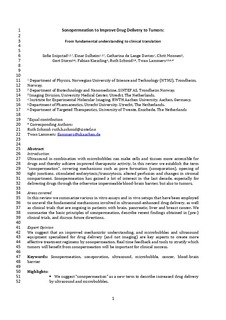| dc.contributor.author | Snipstad, Sofie | |
| dc.contributor.author | Sulheim, Einar | |
| dc.contributor.author | Davies, Catharina de Lange | |
| dc.contributor.author | Moonen, Chrit | |
| dc.contributor.author | Storm, Gert | |
| dc.contributor.author | Kiessling, Fabian | |
| dc.contributor.author | Schmid, Ruth | |
| dc.contributor.author | Lammers, Twan | |
| dc.date.accessioned | 2019-04-01T13:36:58Z | |
| dc.date.available | 2019-04-01T13:36:58Z | |
| dc.date.created | 2019-01-02T13:59:58Z | |
| dc.date.issued | 2018 | |
| dc.identifier.citation | Expert Opinion on Drug Delivery. 2018, 15 (12), 1249-1261. | nb_NO |
| dc.identifier.issn | 1742-5247 | |
| dc.identifier.uri | http://hdl.handle.net/11250/2592747 | |
| dc.description.abstract | Introduction: Ultrasound in combination with microbubbles can make cells and tissues more accessible for drugs, thereby achieving improved therapeutic outcomes. In this review, we introduce the term ‘sonopermeation’, covering mechanisms such as pore formation (traditional sonoporation), as well as the opening of intercellular junctions, stimulated endocytosis/transcytosis, improved blood vessel perfusion and changes in the (tumor) microenvironment. Sonopermeation has gained a lot of interest in recent years, especially for delivering drugs through the otherwise impermeable blood-brain barrier, but also to tumors.
Areas covered: In this review, we summarize various in vitro assays and in vivo setups that have been employed to unravel the fundamental mechanisms involved in ultrasound-enhanced drug delivery, as well as clinical trials that are ongoing in patients with brain, pancreatic, liver and breast cancer. We summarize the basic principles of sonopermeation, describe recent findings obtained in (pre-) clinical trials, and discuss future directions.
Expert Opinion: We suggest that an improved mechanistic understanding, and microbubbles and ultrasound equipment specialized for drug delivery (and not for imaging) are key aspects to create more effective treatment regimens by sonopermeation. Real-time feedback and tools to predict therapeutic outcome and which tumors/patients will benefit from sonopermeation-based interventions will be important to promote clinical translation. | nb_NO |
| dc.language.iso | eng | nb_NO |
| dc.publisher | Taylor & Francis | nb_NO |
| dc.relation.uri | https://www.tandfonline.com/doi/full/10.1080/17425247.2018.1547279 | |
| dc.title | Sonopermeation to improve drug delivery to tumors: from fundamental understanding to clinical translation | nb_NO |
| dc.type | Journal article | nb_NO |
| dc.type | Peer reviewed | nb_NO |
| dc.description.version | acceptedVersion | nb_NO |
| dc.source.pagenumber | 1249-1261 | nb_NO |
| dc.source.volume | 15 | nb_NO |
| dc.source.journal | Expert Opinion on Drug Delivery | nb_NO |
| dc.source.issue | 12 | nb_NO |
| dc.identifier.doi | 10.1080/17425247.2018.1547279 | |
| dc.identifier.cristin | 1648689 | |
| dc.relation.project | Samarbeidsorganet mellom Helse Midt-Norge og NTNU: | nb_NO |
| dc.description.localcode | Locked until 19.11.2019 due to copyright restrictions. This is an [Accepted Manuscript] of an article published by Taylor & Francis in [Expert Opinion on Drug Delivery] on [19 Nov 2018], available at https://doi.org/10.1080/17425247.2018.1547279 | nb_NO |
| cristin.unitcode | 194,66,20,0 | |
| cristin.unitname | Institutt for fysikk | |
| cristin.ispublished | true | |
| cristin.fulltext | preprint | |
| cristin.qualitycode | 1 | |
